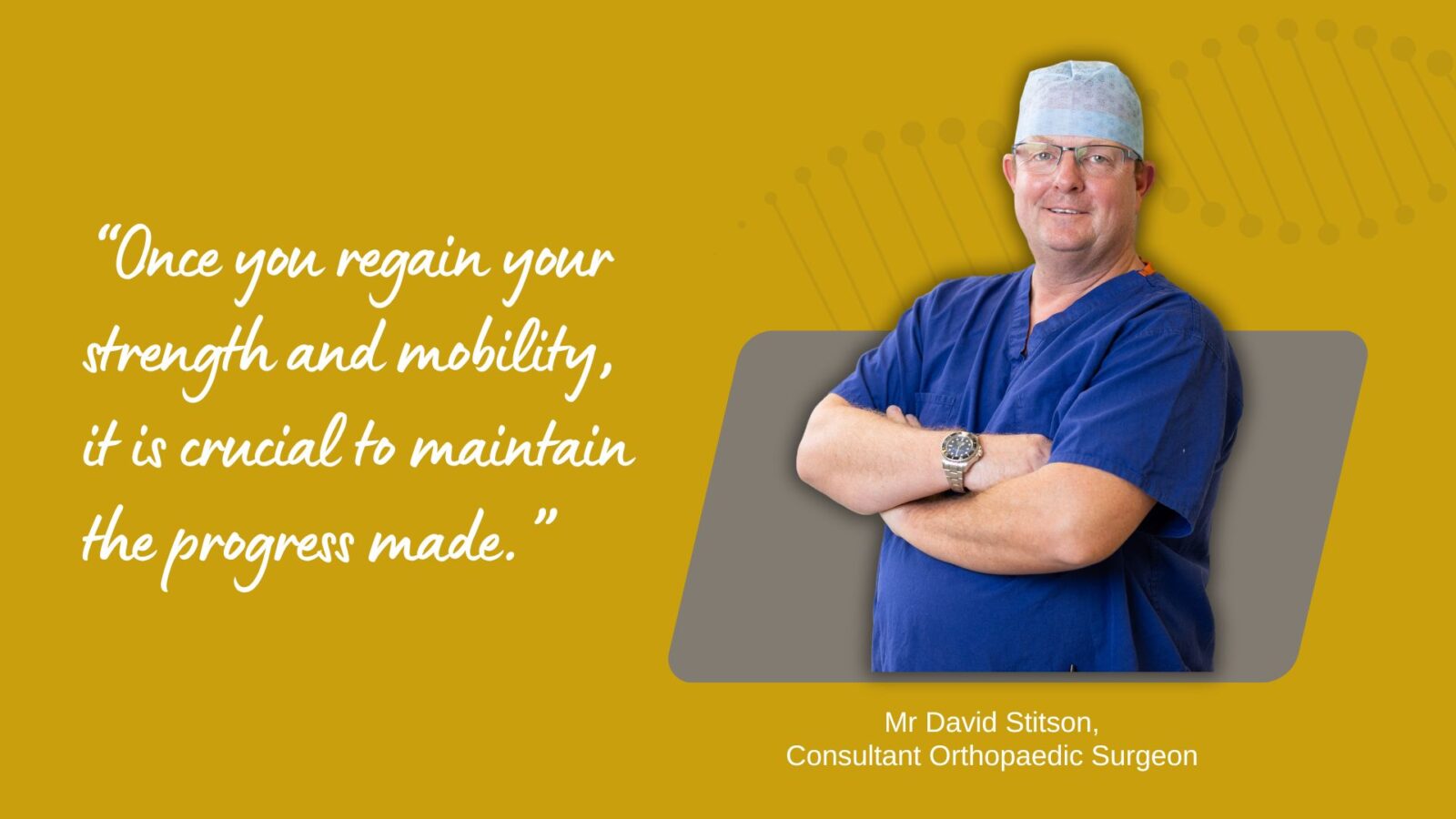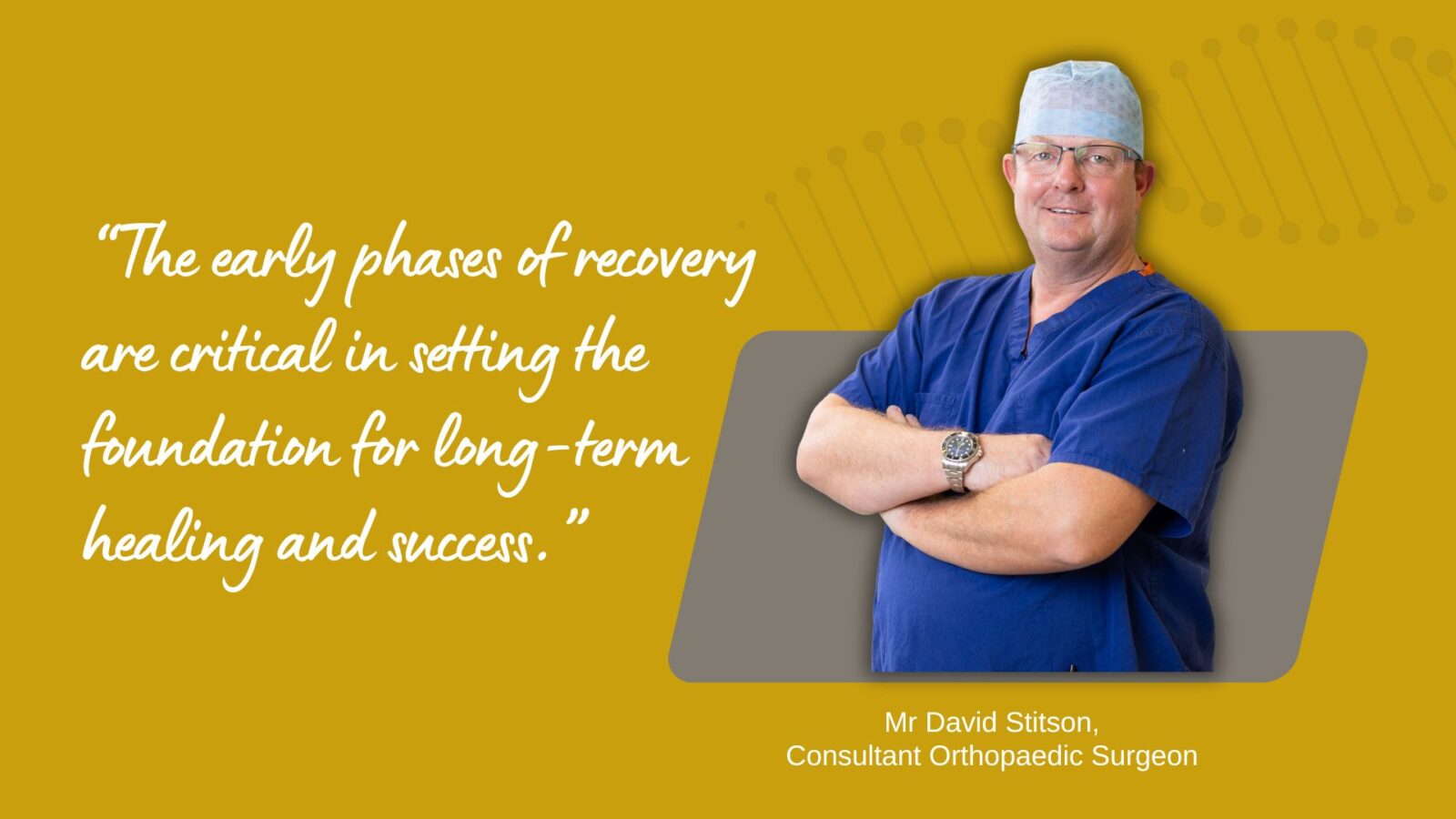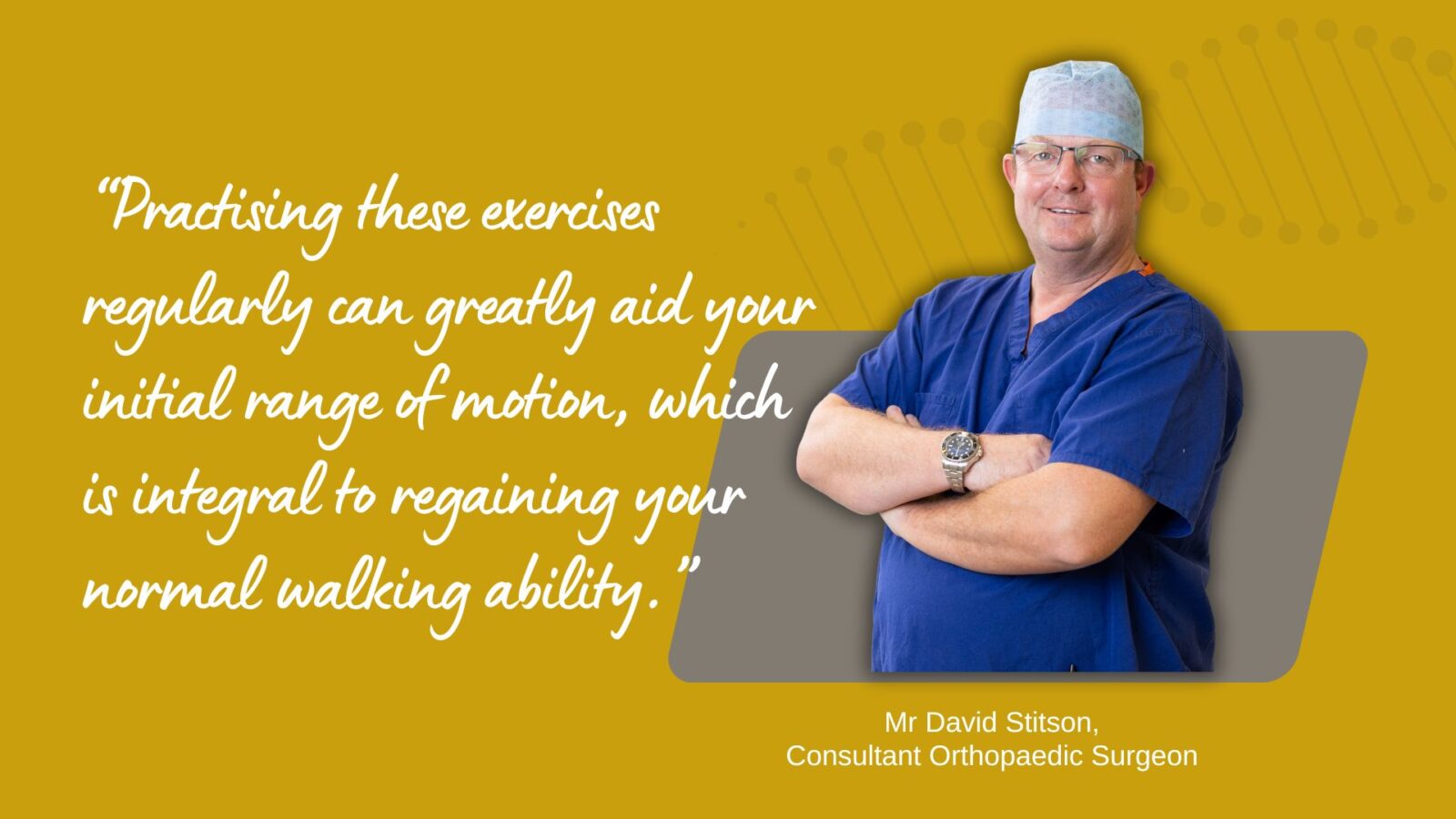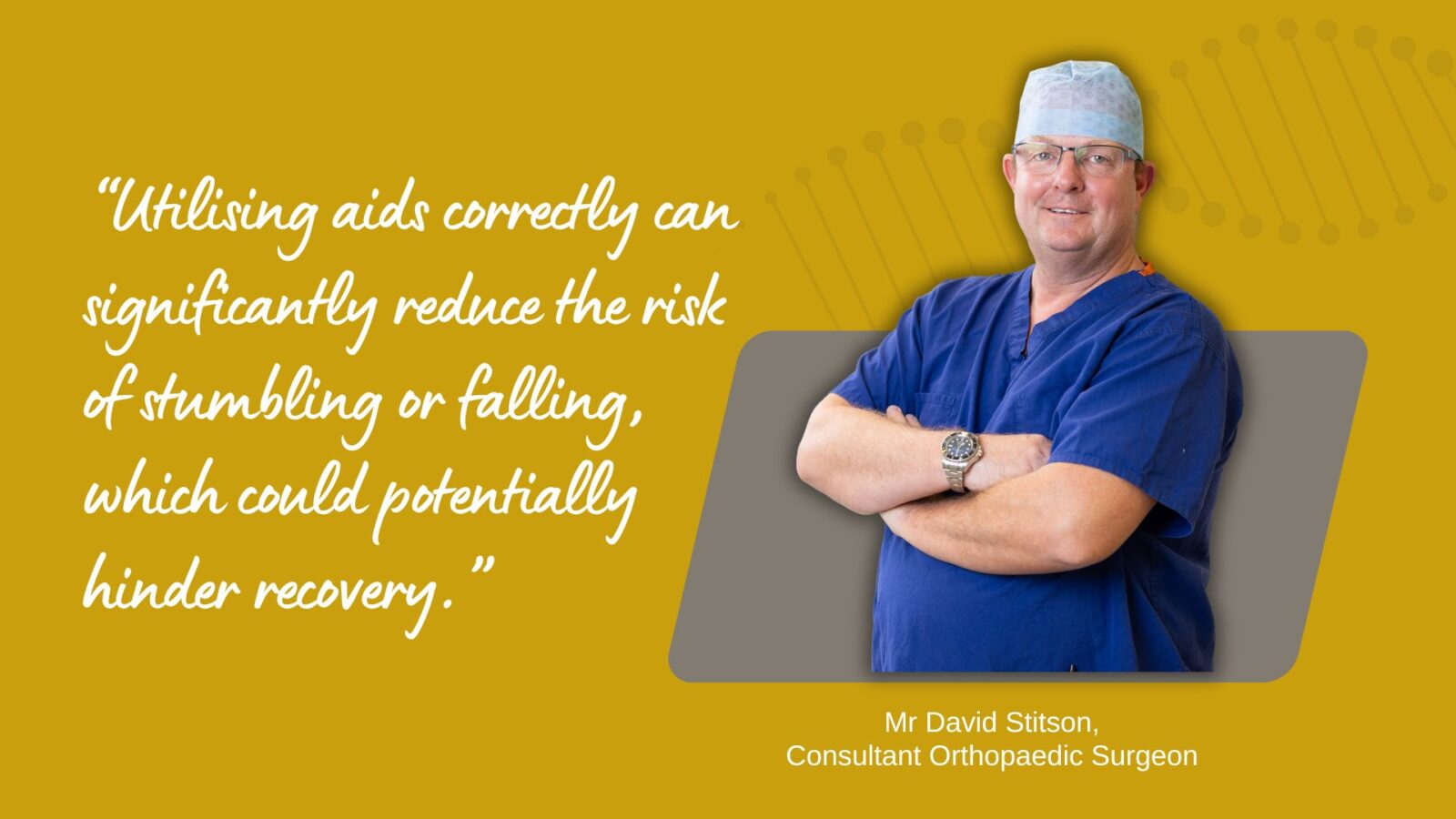Recovering from knee surgery can be challenging, but with the right approach, regaining your ability to walk normally is achievable.
Whether you have undergone a total knee replacement, knee arthroscopy or other surgical procedures, each step towards recovery counts. This guide will provide you with practical tips to support your post-knee-surgery rehabilitation journey.
Contents
Toggle“By focusing on gradual progress, consistency and proper techniques, you can enhance your recovery and embrace a fulfilling, active life once more.”
Understanding Knee Surgery
Knee surgery is a common medical procedure used to treat a range of conditions, including injuries such as torn ligaments and arthritis. It is vital to have a clear understanding of the procedure and its implications, as this knowledge can pave the way for a smoother and more manageable recovery process.
Types of Knee Surgery
There are several types of knee surgery, carried out by Mr Stitson, designed to address specific issues:
– Knee Arthroscopy: A minimally invasive procedure used to diagnose and treat issues within the knee joint. It involves small incisions and utilises a camera to guide the surgery.
– Partial Knee Replacement: Involves replacing only the damaged part of the knee with artificial components while preserving healthy bone and tissue.
– Total Knee Replacement: The most extensive form of knee surgery, where the entire knee joint is replaced with a prosthetic joint.
Understanding which type of knee surgery you have undergone is critical, as each has its unique rehabilitation needs and timelines.
Importance of Post Knee-Surgery Rehabilitation
Post-knee-surgery rehabilitation is a cornerstone of recovery and gaining back normal mobility. Proper rehabilitation prevents stiffness, bolsters healing and strengthens the surrounding muscles. This stage is crucial for restoring function to the knee and ensuring a successful surgical outcome, minimising the risk of complications or further injury.
Common Challenges in Knee Surgery Recovery
Recovery after knee surgery is certainly does present challenges. Common issues may include:
– Limited Mobility: Initially, movement is restricted and regaining full knee movement may take time.
– Pain and Swelling: Discomfort and inflammation are common after surgery and need to be managed effectively.
– Emotional Impact: The journey can be mentally taxing, sometimes leading to frustration or anxiety as progress might feel slow.
Being aware of these challenges can help patients prepare both mentally and physically for the journey ahead.
Initial Recovery Steps Post Knee-Surgery
The early phases of recovery are critical in setting the foundation for long-term healing and success. Taking structured steps and following medical advice from Mr Stitson can facilitate smoother recuperation.
Setting Realistic Expectations
One of the most beneficial things you can do is set realistic expectations from the onset. Recovery timelines can differ significantly from one individual to another based on the type of surgery, age, and general health condition. This means:
– Recognising that recovery is a gradual process and may take weeks to months.
– Understanding that setbacks can occur and that patience is essential.
– Staying committed to the rehabilitation process for sustainable improvement.
Importance of Rest and Elevation
Rest is indispensable in the initial recovery period. It allows the body to heal naturally without the strain of undue movement. Follow these tips:
– Prioritise rest: Regular rest periods should be built into your daily schedule.
– Elevate your leg: Elevating the operated knee can help reduce swelling and improve comfort. Ideally, keep the leg elevated above the level of your heart when resting.
– Use aids: Don’t shy away from using mobility aids such as crutches or walking sticks, which can provide much-needed support and reduce the risk of injury.
Managing Pain and Swelling
Pain and swelling are common companions in the journey back to normal walking post-knee surgery. Here are strategies to manage these symptoms:
– Medication: Follow the prescribed pain-relief medication schedule to manage discomfort effectively.
– Cold Therapy: Applying ice or cold packs to the knee can significantly help reduce swelling and numb pain.
– Compression Garments: Compression bandages or socks can also aid in controlling swelling and improving circulation.
By understanding and implementing these initial recovery steps, individuals can lay a solid groundwork for a more effective and less troublesome rehabilitation journey.
Exercises for Regaining Knee Strength
Gentle Range-of-Motion Exercises
Regaining full range of motion in your knee is crucial following surgery, as it lays the foundation for strength-building exercises. Start with gentle exercises designed to increase your knee’s flexibility without causing strain.
– Heel Slides: Sit or lie down, then slowly slide your heel towards your buttocks, bending your knee as far as possible without discomfort. Hold this position for a few seconds and then slide back to the starting position. Repeat this 10-15 times.
– Ankle Pumps: While sitting or lying down, flex and point your toes upwards and downwards. This movement, apart from improving motion, helps in reducing swelling by boosting circulation.
– Quad Sets: Sit with your legs straight out in front of you. Tighten the muscles on the top of your thigh, pressing the back of your knee downward into the surface. Hold this tension for about five seconds and then release. Aim for 10-15 repetitions.
Practising these exercises regularly can greatly aid in maintaining the initial range of motion, which is integral to regaining normal walking ability.
Building Strength with Low-Impact Activities
Once your range of motion improves, focus on building strength using low-impact activities. These activities are gentle on the knee yet effective in promoting muscular endurance.
– Stationary Cycling: Engage in low-resistance cycling to boost knee strength and flexibility. It is advisable to start with short durations and gradually increase as you build endurance.
– Swimming and Aqua Therapy: Water provides buoyancy, reducing stress on the knee while offering resistance that is excellent for muscle building. Swimming or even walking in a shallow pool can be beneficial.
– Leg Raises: While lying on your back, lift your leg straight upwards and hold for a few seconds. Alternating legs and repeating this exercise helps in enhancing quad muscle strength.
Integrating these activities into your routine boosts your knee’s endurance and prepares you for more challenging exercises.
Progression to Weight-Bearing Exercises
As your knee’s strength and flexibility improve, you can begin incorporating weight-bearing exercises. These are crucial for making your knee resilient and better adept at handling daily activities.
– Partial Squats: Stand with feet shoulder-width apart and gently lower your body into a squat, not going lower than a seated position. This exercise engages the entire lower limb effectively without overloading the joint.
– Step-Ups: Using a step or a low platform, step up with your injured leg and follow with the other leg before stepping back down. Start with a manageable height and increase as comfort improves.
– Calf Raises: Stand near a wall or furniture for support and slowly raise your heels off the ground, standing on your toes. This strengthens the lower leg and balance control.
Employing these exercises facilitates a smoother transition back to routine walking.
3 Essential Tips for Walking Normally After Knee Surgery
1. Utilising Walking Aids Effectively
Initially, it is often necessary to use walking aids such as crutches, walking sticks or a walker. These should be used as instructed by Mr Stitson to prevent overexertion of the knee.
– Ensure the aid is at the correct height, so your elbow is bent slightly when holding the grip.
– Gradually wean off the aid as your strength and balance improve.
Utilising aids correctly can significantly reduce the risk of stumbling or falling, which could potentially hinder recovery.
2. Practising Gait Exercises
Developing a proper walking pattern, or gait, is essential to prevent strain on other parts of the body. Focus on exercises that promote an even and balanced gait.
– Heel-to-Toe Walking: Concentrate on landing softly with your heel and rolling through to push off with your toes. This promotes a natural gait and supports recovery.
– Walking with Core Engagement: Tightening your abdominal muscles as you walk can help support your lower back and promote an upright posture.
Correcting gait is crucial for returning to normal activities smoothly.
3. Monitoring Progress and Making Adjustments
Throughout your recovery, it is vital to monitor your progress and make necessary adjustments. Keep track of knee pain levels, swelling, and mobility improvements.
– Maintain a journal to record daily activities and any discomfort experienced.
– Regular follow-ups with your physiotherapist can ensure that exercises are being done correctly, and modifications are made if necessary.
By tracking your progress diligently, you can confidently stride towards regaining normal walking patterns post-knee surgery.
Next Steps
Once you regain your strength and mobility, it is crucial to maintain the progress made. Continue incorporating exercises that strengthen your knee and muscles in your routine. Here are some next steps to consider:
– Exercise Regularly: Follow a personalised exercise plan tailored by your physiotherapist.
– Stay Active: Engage in low-impact activities like swimming or cycling.
– Monitor Your Progress: Keep track of improvements and consult your healthcare provider if needed.
Be mindful of your body and avoid activities that cause discomfort. Regular check-ups and adjusting exercises based on professional advice ensure a balanced and effective recovery.
Remember, patience and dedication are key to returning to your normal walking pattern.
It is essential to discuss all your options with Mr Stitson, who can guide you through the treatment process and advise on how you can achieve the best possible outcome.
About Knee Surgery
Knee replacement surgery replaces the worn out, painful and stiff knee joint with a new prosthetic joint. This procedure which may be a partial or a total replacement is normally performed under spinal anaesthesia and is usually followed by a night or two in the hospital. Day-case knee replacement surgery may be an appropriate option for you.

About Mr Stitson
David Stitson is a Plymouth-based Consultant Trauma and Orthopaedic Surgeon. Trained both in the UK and internationally, he has worked in medicine for more than 20 years for the NHS, for the Royal Air Force and in private practice. Mr Stitson operates privately at the Nuffield Health Hospital, Plymouth.

The Nuffield Plymouth CQC Rating
The Nuffield Hospital has a history that spans over half a century and has built a reputation for high standards of care, professionalism and expertise in delivering health services. They aim for continuous quality improvement in everything they do.
Active Quality and Governance programmes are in place at the Nuffield Hospital Plymouth. As part of this, the hospital is inspected by independent healthcare regulators to ensure it meets the fundamental standards of quality and safety as determined by the regulating body (CQC).
In the most recent inspection, Plymouth Nuffield Hospital was rated as ‘Good’ overall, however, the surgical element of the inspection was rated as ‘Outstanding’. The hospital was referred to as:
“Outstanding in effective and caring, and
Good in safe, responsive and well-led.”








